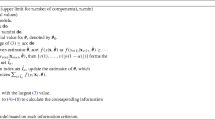Abstract
We consider an equivariant approach imposing data-driven bounds for the variances to avoid singular and spurious solutions in maximum likelihood estimation of clusterwise linear regression models. We investigate its use in the choice of the number of components and we propose a computational shortcut, which significantly reduces the computational time needed to tune the bounds on the data. In the simulation study and the two real-data applications, we show that the proposed methods guarantee a reliable assessment of the number of components compared to standard unconstrained methods, together with accurate model parameters estimation and cluster recovery.




Similar content being viewed by others
Notes
Computer programs are available from the corresponding author upon request.
We checked that this is also the case for \(n>200\). Related figures are available from the corresponding author upon request.
References
Alfó M, Viviani S (2016) Finite mixtures of structured models. In: Hennig C, Meila M, Murtagh F, Rocci R (eds) Handbook of cluster analysis. Chapman & Hall, Boca Raton, pp 217–240
Arlot S, Celisse A (2010) Cross-validation procedures for model selection. Stat Surv 4:40–79
Bagirov AM, Ugon J, Mirzayeva H (2013) Nonsmooth nonconvex optimization approach to clusterwise linear regression problems. Eur J Oper Res 229(1):132–142
Carbonneau RA, Caporossi G, Hansen P (2011) Globally optimal clusterwise regression by mixed logical-quadratic programming. Eur J Oper Res 212(1):213–222
Cerioli A, García-Escudero LA, Mayo-Iscar A, Riani M (2017) Finding the number of groups in model-based clustering via constrained likelihoods. J Comput Graph Stat. https://doi.org/10.1080/10618600.2017.1390469
Day NE (1969) Estimating the components of a mixture of two normal distributions. Biometrika 56:463–474
Dempster AP, Laird NM, Rubin DB (1977) Maximum likelihood from incomplete data via the EM algorithm. J R Stat Soc Ser B (Stat Methodol) 39:1–38
Di Mari R, Rocci R, Gattone SA (2017) Clusterwise linear regression modeling with soft scale constraints. Int J Approx Reason 91:160–178
Fraley C, Raftery AE (2007) Bayesian regularization for normal mixture estimation and model-based clustering. J Classif 24(2):155–181
García-Escudero LA, Gordaliza A, Greselin F, Ingrassia S, Mayo-Iscar A (2017) Eigenvalues and constraints in mixture modeling: geometric and computational issues. Adv Data Anal Classif. https://doi.org/10.1007/s11634-017-0293-y
Hathaway RJ (1985) A constrained formulation of maximum-likelihood estimation for normal mixture distributions. Ann Stat 13:795–800
Hennig C, Liao TF (2013) How to find an appropriate clustering for mixed-type variables with application to socio-economic stratification. J R Stat Soc Ser C 62(3):309–369
Hubert L, Arabie P (1985) Comparing partitions. J Classif 2:193–218
Ingrassia S (2004) A likelihood-based constrained algorithm for multivariate normal mixture models. Stat Methods Appl 13:151–166
Ingrassia S, Rocci R (2007) A constrained monotone EM algorithm for finite mixture of multivariate Gaussians. Comput Stat Data Anal 51:5339–5351
Keribin C (2000) Consistent estimation of the order of mixture models. Sankhyā 62:49–66
Kiefer NM (1978) Discrete parameter variation: efficient estimation of a switching regression model. Econometrica 46:427–434
Kiefer J, Wolfowitz J (1956) Consistency of the maximum likelihood estimator in the presence of infinitely many incidental parameters. Ann Math Stat 27:886–906
Kim D, Seo B (2014) Assessment of the number of components in Gaussian mixture models in the presence of multiple local maximizers. J Multivar Anal 125:100–120
Koehler AB, Murphree ES (1988) A comparison of the Akaike and Schwarz criteria for selecting model order. Appl Stat 37:187–195
Leroux BG (1992) Consistent estimation of a mixing distribution. Ann Stat 20:1350–1360
McLachlan GJ, Peel D (2000) Finite mixture models. Wiley, New York
Quandt RE (1972) A new approach to estimating switching regressions. J Am Stat Assoc 67(338):306–310
Quandt RE, Ramsey JB (1978) Estimating mixtures of normal distributions and switching regressions. J Am Stat Assoc 73(364):730–738
Ritter G (2014) Robust cluster analysis and variable selection. Monographs on statistics and applied probability, vol 137. CRC Press
Rocci R, Gattone SA, Di Mari R (2017) A data driven equivariant approach to constrained Gaussian mixture modeling. Adv Data Anal Classif. https://doi.org/10.1007/s11634-016-0279-1
Seo B, Kim D (2012) Root selection in normal mixture models. Comput Stat Data Anal 56:2454–2470
Seo B, Lindsay BG (2010) A computational strategy for doubly smoothed MLE exemplified in the normal mixture model. Comput Stat Data Anal 54(8):1930–1941
Smyth P (1996) Clustering using Monte-Carlo cross validation. In: Proceedings of the second international conference on knowledge discovery and data mining, Menlo Park, CA, AAAI Press, pp 126–133
Smyth P (2000) Model selection for probabilistic clustering using cross-validated likelihood. Stat Comput 10(1):63–72
Zou H, Hastie T, Tibshirani R (2007) On the “degrees of freedom” of the lasso. Ann Stat 35(5):2173–2192
Author information
Authors and Affiliations
Corresponding author
Additional information
Publisher's Note
Springer Nature remains neutral with regard to jurisdictional claims in published maps and institutional affiliations.
Rights and permissions
About this article
Cite this article
Di Mari, R., Rocci, R. & Gattone, S.A. Scale-constrained approaches for maximum likelihood estimation and model selection of clusterwise linear regression models. Stat Methods Appl 29, 49–78 (2020). https://doi.org/10.1007/s10260-019-00480-y
Accepted:
Published:
Issue Date:
DOI: https://doi.org/10.1007/s10260-019-00480-y




